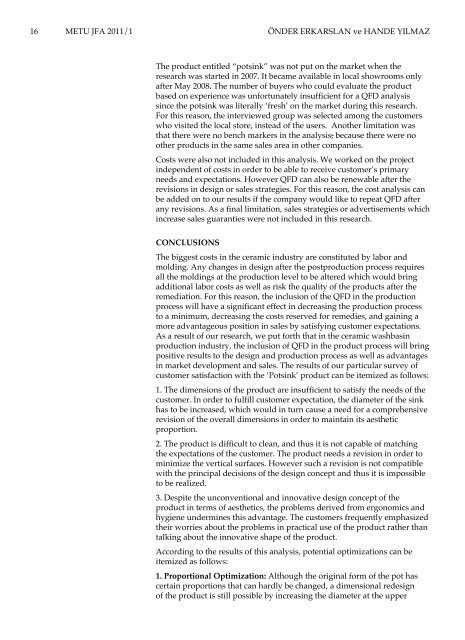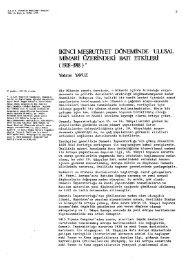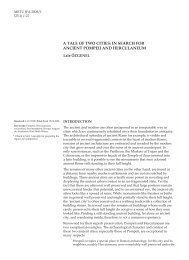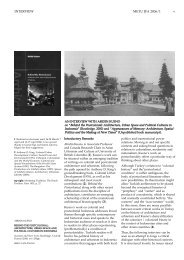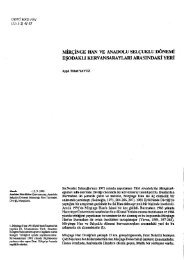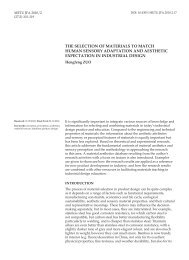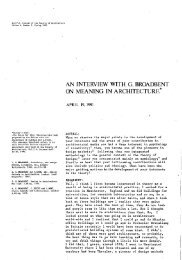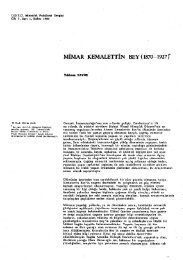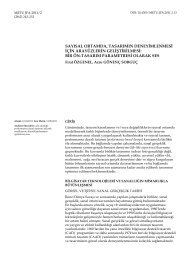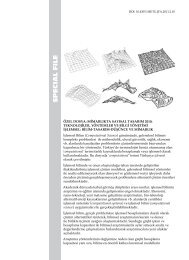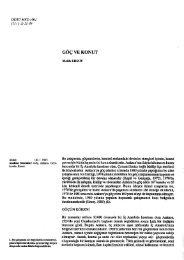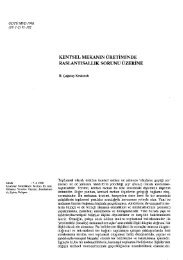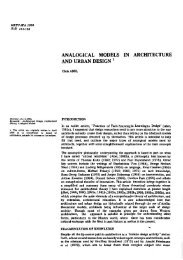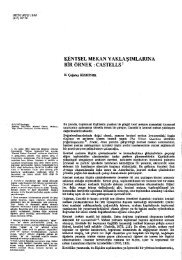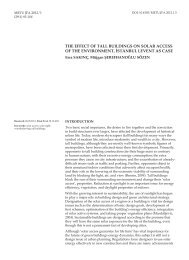Optimization of product design through quality function deployment
Optimization of product design through quality function deployment
Optimization of product design through quality function deployment
You also want an ePaper? Increase the reach of your titles
YUMPU automatically turns print PDFs into web optimized ePapers that Google loves.
16 METU JFA 2011/1<br />
ÖNDER ERKARSLAN ve HANDE YILMAZ<br />
The <strong>product</strong> entitled “potsink” was not put on the market when the<br />
research was started in 2007. It became available in local showrooms only<br />
after May 2008. The number <strong>of</strong> buyers who could evaluate the <strong>product</strong><br />
based on experience was unfortunately insufficient for a QFD analysis<br />
since the potsink was literally ‘fresh’ on the market during this research.<br />
For this reason, the interviewed group was selected among the customers<br />
who visited the local store, instead <strong>of</strong> the users. Another limitation was<br />
that there were no bench markers in the analysis, because there were no<br />
other <strong>product</strong>s in the same sales area in other companies.<br />
Costs were also not included in this analysis. We worked on the project<br />
independent <strong>of</strong> costs in order to be able to receive customer’s primary<br />
needs and expectations. However QFD can also be renewable after the<br />
revisions in <strong>design</strong> or sales strategies. For this reason, the cost analysis can<br />
be added on to our results if the company would like to repeat QFD after<br />
any revisions. As a final limitation, sales strategies or advertisements which<br />
increase sales guaranties were not included in this research.<br />
CONCLUSIONS<br />
The biggest costs in the ceramic industry are constituted by labor and<br />
molding. Any changes in <strong>design</strong> after the post<strong>product</strong>ion process requires<br />
all the moldings at the <strong>product</strong>ion level to be altered which would bring<br />
additional labor costs as well as risk the <strong>quality</strong> <strong>of</strong> the <strong>product</strong>s after the<br />
remediation. For this reason, the inclusion <strong>of</strong> the QFD in the <strong>product</strong>ion<br />
process will have a significant effect in decreasing the <strong>product</strong>ion process<br />
to a minimum, decreasing the costs reserved for remedies, and gaining a<br />
more advantageous position in sales by satisfying customer expectations.<br />
As a result <strong>of</strong> our research, we put forth that in the ceramic washbasin<br />
<strong>product</strong>ion industry, the inclusion <strong>of</strong> QFD in the <strong>product</strong> process will bring<br />
positive results to the <strong>design</strong> and <strong>product</strong>ion process as well as advantages<br />
in market development and sales. The results <strong>of</strong> our particular survey <strong>of</strong><br />
customer satisfaction with the ‘Potsink’ <strong>product</strong> can be itemized as follows:<br />
1. The dimensions <strong>of</strong> the <strong>product</strong> are insufficient to satisfy the needs <strong>of</strong> the<br />
customer. In order to fulfill customer expectation, the diameter <strong>of</strong> the sink<br />
has to be increased, which would in turn cause a need for a comprehensive<br />
revision <strong>of</strong> the overall dimensions in order to maintain its aesthetic<br />
proportion.<br />
2. The <strong>product</strong> is difficult to clean, and thus it is not capable <strong>of</strong> matching<br />
the expectations <strong>of</strong> the customer. The <strong>product</strong> needs a revision in order to<br />
minimize the vertical surfaces. However such a revision is not compatible<br />
with the principal decisions <strong>of</strong> the <strong>design</strong> concept and thus it is impossible<br />
to be realized.<br />
3. Despite the unconventional and innovative <strong>design</strong> concept <strong>of</strong> the<br />
<strong>product</strong> in terms <strong>of</strong> aesthetics, the problems derived from ergonomics and<br />
hygiene undermines this advantage. The customers frequently emphasized<br />
their worries about the problems in practical use <strong>of</strong> the <strong>product</strong> rather than<br />
talking about the innovative shape <strong>of</strong> the <strong>product</strong>.<br />
According to the results <strong>of</strong> this analysis, potential optimizations can be<br />
itemized as follows:<br />
1. Proportional <strong>Optimization</strong>: Although the original form <strong>of</strong> the pot has<br />
certain proportions that can hardly be changed, a dimensional re<strong>design</strong><br />
<strong>of</strong> the <strong>product</strong> is still possible by increasing the diameter at the upper


